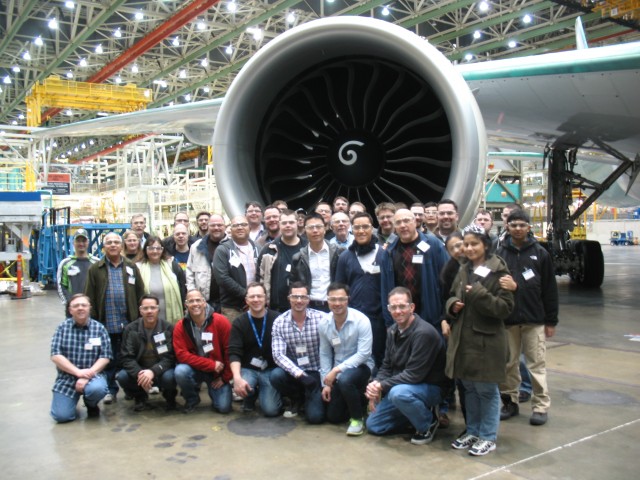
One of three Aviation Geek Fest groups that toured the Boeing Factory Floor. Photo by Boeing.
This weekend was amazing. Almost 200 people attended Aviation Geek Fest 2013 in Seattle this year — it was bigger and better than ever.
Many attendees came from the Seattle area, but we are quite a few who came from out of state: Colorado, Oregon, Minnesota, Arizona, Georgia, Florida, New York, Texas, North Carolina, Nevada, Montana, Hawaii, Massachusetts and California.
The group was also international. There were a few folks from Canada (British Columbia, Ontario and Quebec) and a father and son came all the way from Oslo Norway for the event. This has truly turned into a world event and it makes sense since Seattle is a major hub for aviation lovers. Awesome.

The point of the event is to bring aviation lovers (or AvGeeks) together to celebrate our passion and do some pretty cool things together.

We all got to check out the new space exhibits, including the Space Shuttle trainer at the Museum of Flight. Image by AirlineReporter.com.
This was the first year where the event was two days. Saturday, the 16th, took place down south at Boeing Field and Sunday took place up north at Paine Field. Starting at 9am, AvGeeks were able to enter the Museum of Flight and start their aviation adventure.
Our group had own room up on the top floor, overlooking the runway with free coffee, tea and water — all of which was needed to keep up during the day. The 737 tour was not until, noon, which gave people plenty of time to check out the Museum of Flight.
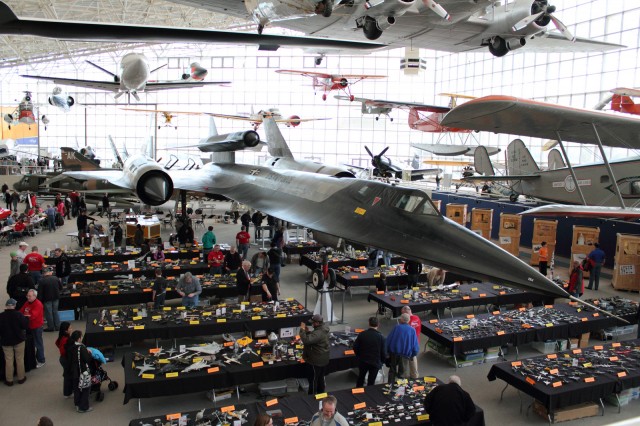
There was a model show going on at the Museum of Flight. Image by AirlineReporter.com.
I spent the morning up at #AGF13 HQ (the room at the Museum of Flight) talking aviation and airlines with all the AvGeeks that showed up. At about noon, it was time for us to prepare to get on the three buses to be taken to the Renton 737 Factory. The only down side to the tour is we were not allowed to take any of our own photos. Luckily, Boeing agreed to take some photos for us and share them.
On the ride over to the 737 factory, I Tweeted out a photo of the AvGeeks on my bus and was told they looked sad. This was because I just got done telling them, “no phones and no cameras,” then took the photo. Right after, I also explained that everyone was getting a free $20 gift card to The Boeing Store — that is when I should have taken the photo — oops.
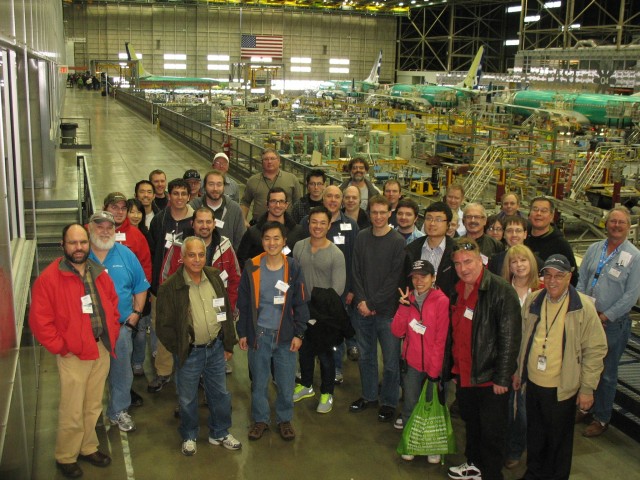
One of the AGF13 groups inside the Renton 737 Factory. Photo by Boeing.
Our 737 tour started with a few short videos highlighting the 737 and of course the new MAX. This tour was super VIP, since it is not open to the public and they stated that this was the largest group that have toured the facility. We were broken into four groups and taken down both of the 737 lines. Since it was Saturday, the line was not moving, but we all enjoyed figuring out the airlines that the 737s belonged to by the liveries on their rudders and winglets. Not too surprising, there was not one livery that could stump our group.
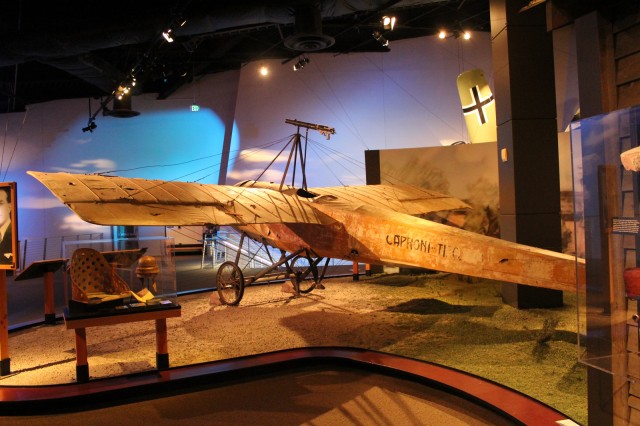
The world’s first fighter plane: the Caproni Ca.20 at the Museum of Flight. Image by AirlineReporter.com.
After the tour, it was back on the buses and we headed back to the Museum of Flight. I hadn’t been in a few years, so I took about two hours quickly going through their new shuttle trainer and checking out old friends (Concorde, first Boeing 747, Constellation, among others) in the Air Park. The museum closed at 5pm, but we were given a special after hours tour of the Personal Courage Wing, which shows off aircraft and memorabilia from World War I and II.
By the time our tour was done at 6:30pm I was quite tired. Really we only had one scheduled event: the 737 tour, but everyone was kept busy the entire day. It was a great day, but I was excited for the next.
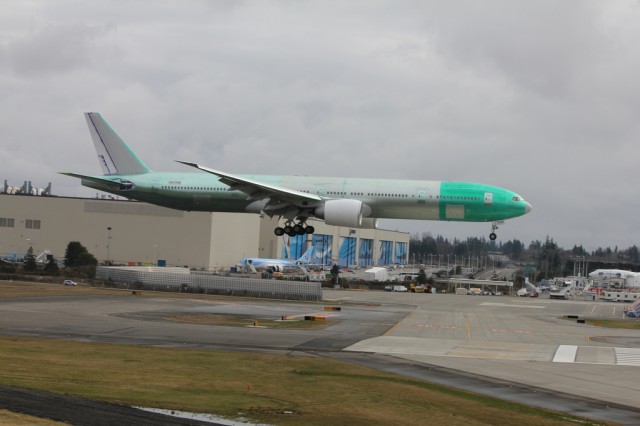
Upon arriving at the Future of Flight, we were greeted by a few Boeing 777’s viewed from the Strato Deck. Image by AirlineReporter.com.
I was up earlier than I normally am during the weekend, but I didn’t even need coffee right away, I had AvGeek adrenaline in my blood. Shortly after arriving at the Future of Flight, we were treated with a few Boeing 777 test flights, viewed from the strato deck. Like down south, we had our own AGF13 room with coffee to fuel us through the day.
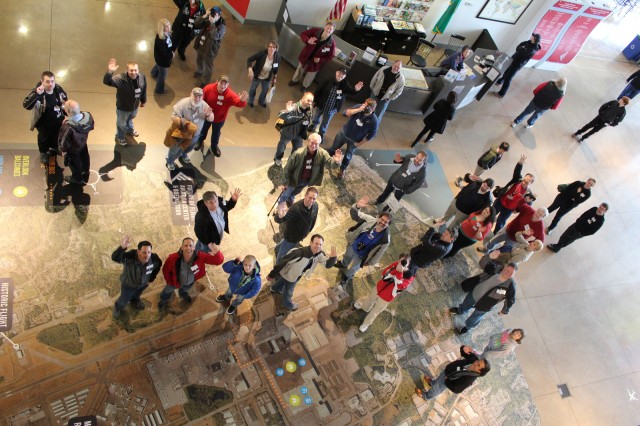
Getting ready to head to the Dreamliner Gallery, AvGeeks hang out at the Future of Flight. Image from AirlineReporter.com
Throughout the day, AvGeeks had the ability to check out the Future of Flight, Historic Flight Foundation and the Flying Heritage Collection free of charge. Although I wasn’t able to do everything, it was fun watching the #AGF13 hashtag on Twitter to see what everyone else was up to. I was hoping to get over to also see the Flying Heritage Collection and the Museum of Flight Restoration Center, but I just ran out of time — next year I promise.
Our Boeing Factory floor tour was set at 3pm. Before hand, at 10am, 11:30am and finally at 1pm, there were separate tours to the Dreamliner Gallery.
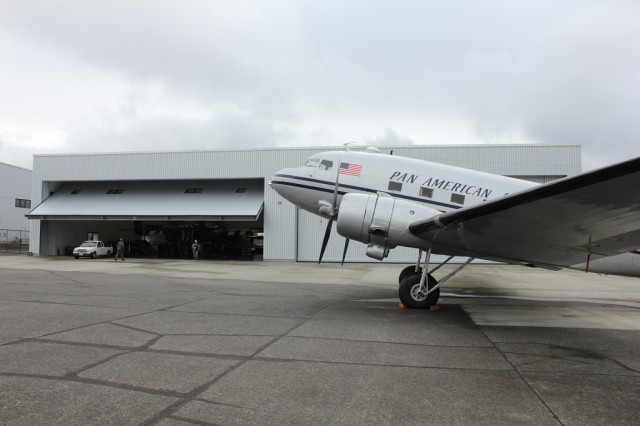
Restored Pan Am DC-3 at Historic Flight. Image by AirlineReporter.com.
My tour wasn’t until 1pm, but I was once again enjoying talking with the other AvGeeks who were hanging out at the Future of Flight. At about noon a group of us saw via social media that the DC-3 at Historic Flight Foundation was open and very quickly, we were all piled into a car and headed over. I don’t think I have seen a group of AvGeeks move so fast.
I have seen the outside of the plane before, but never the inside — she is a beauty. Historic Flight is hoping to offer rides to paying passengers later in the year (hopefully more on that in a future story).
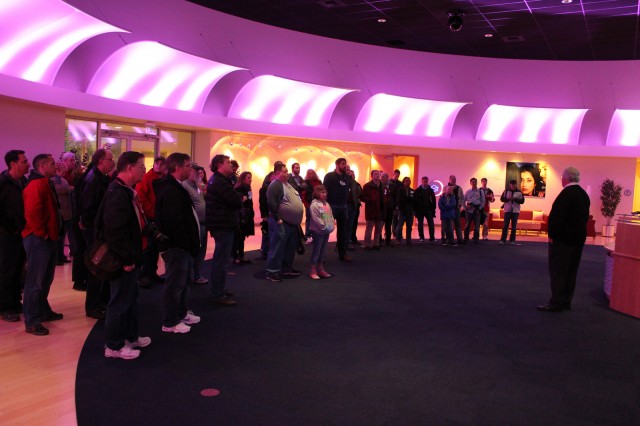
Our group got to check out the Dreamliner Gallery. Image by AirlineReporter.com.
After grabbing a quick lunch, we hurried back to the Future of Flight to catch our bus to the Dreamliner Gallery. The gallery is the place where airlines go to design the interiors of their 787’s. This is the first facility like this in the world that allows customers to figure out so many options at one place, greatly reducing the time and money spent to prepare a new aircraft to join their fleet.
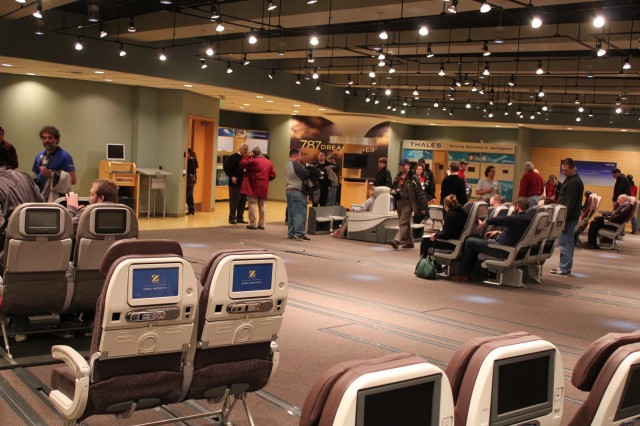
Checking out the different seating options of the Dreamliner. Image by AirlineReporter.com.
Like the 737 factory, the Dreamliner Gallery is not normally open to the public. We went room-to-room looking at seats, lighting, galley options, lavatories and even crew rest areas. None of us wanted to leave, but we were excited to take our Boeing Factory floor tour. We boarded our bus again and headed back to the Future of Flight for a short video before getting on another set of buses to be taken to the factory.
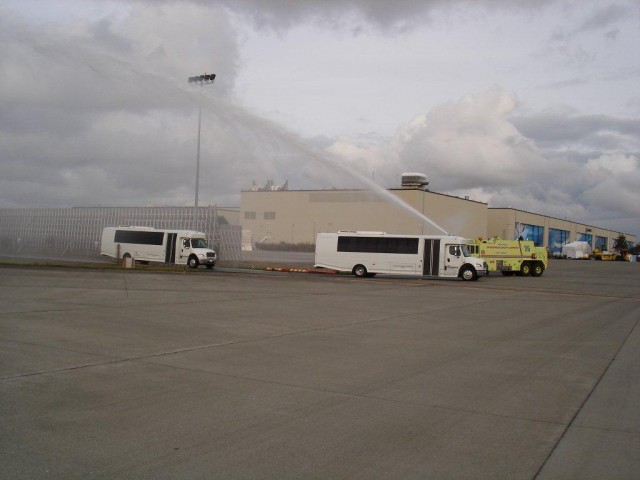
Three of the buses got a water canon salute. Photo by Snohomish County Airport Fire Dept.
It is a nice tradition that aircraft get a water canon salute — our buses were no different — at least most of our buses. We were split up into four different buses and just so happens that two of the buses (one which I was on) missed the water canon salute. The other two received a nice wash down from the Snohomish County Airport Fire Department. Kindly, one of the fire fighters took photos and shared them with us.

AvGeeks in front of a Boeing 747-8I on the factory floor in Everett. Photo by Boeing.
Our four AvGeek groups toured around the factory floor, including the new 787 surge line. I have toured the factory a number of times now, but each time is a bit different and it never gets old walking among the brand new airliners. Being on the floor is very different than the public tour that takes place up on the walking platforms. I much more enjoy looking up at a 777, 787 or 747-8 than looking down.
After our tour, it was back on the buses and to the Future of Flight for an AvGeek social with pizza and beer.
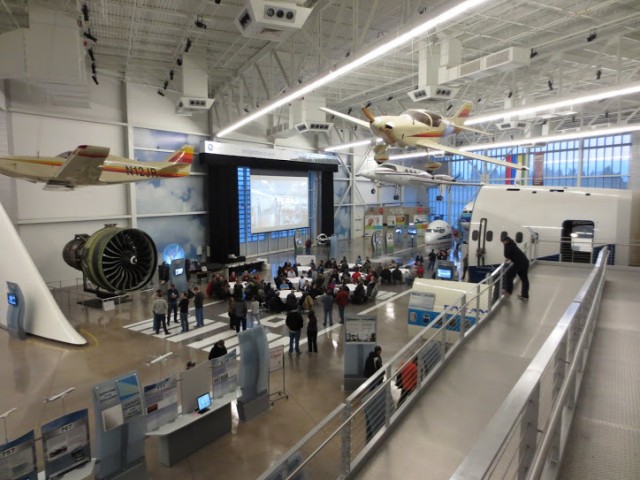
The Future of Flight gallery floor set up in AvGeek social-mode. Image by Mal Muir.
Part of the social was giving out a number of prizes, including two free tickets on Southwest Airlines. By the time I was heading home, I was exhausted — but in a good way. There was quite a bit of walking, talking and learning and I was so thankful everything went so smoothly.

Will there be an Aviation Geek Fest 2014? Heck yes there will! Start preparing now.
We are going to set the date to be President’s Day Weekend for next year, which is February 15th and 16th, 2014. The event will likely be similar with new and exciting things. Be sure to add your email to the AGF e-mail list (if you already signed up for AGF13, you do NOT need to sign up again). No details yet, but we are planning for it to be epic.
A huge thanks to…. the Future of Flight, Boeing, Museum of Flight, Historic Flight Foundation, the Flying Heritage Collection, Southwest Airlines and everyone else who helped to make this an amazing event. I cannot wait until next year!
125 PHOTOS OF AVIATION GEEK FEST
More AGF13 Goodies:
 |
This story written by…David Parker Brown, Editor & Founder. David started AirlineReporter.com in the summer of 2008, but has had a passion for aviation since he was a kid. Born and raised in the Seattle area (where he is currently based) has surely had an influence and he couldn’t imagine living anywhere else in the world.@AirlineReporter | Flickr | YouTube |
Friends of mine, Maresa, recently started a new blog that looks at all the great opportunities around the greater Seattle area called AroundPugetSound.net. She recently visited the Flying Heritage Collection and did a great review that I wanted to share. She is not an aviation geek, so it is great to see a review from the perspective of those who just have an interest in the area, history and how things work. Here is Maresa’s review in her own words…
My grandfather came into town from Minnesota last week to visit; he’s been a pilot for over 50 years. My husband and I always like taking Grandpa on flying-related outings whenever he’s in town. Last year we explored the Future of Flight together and he’s visited the Museum of Flight at Boeing Field in the past. This year we needed something different. Lucky for us we recently heard about Paul Allen’s airplanes at Paine Field in Everett: The Flying Heritage Collection. When we arrived at the Flying Heritage Collection, we were escorted back through history and it has now become one of our favorite museums.
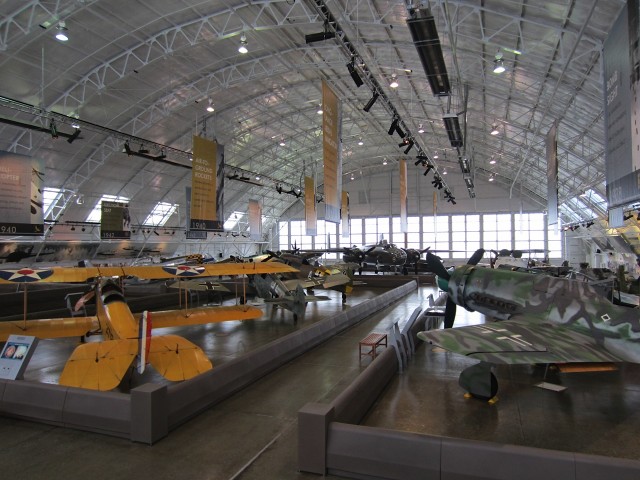
A look at the Paul Allen's historic WWII collection of war-time airplanes
The Flying Heritage Collection
Next to all of the giant Boeing hangers, Paul Allen’s hangar doesn’t appear very big. But, once inside the museum hangar, you’ll find they have fit 16 aircraft–mostly from the World War II era– two WWII army tanks, and two missiles. They also have a replica of SpaceShipOne, the first private-venture rocket ship. State of the art restoration techniques have been used to refurbish these vintage airplanes and other artifacts. Many of the planes have stories. For example, the Messerschmitt BF 109 E-3 (Emil), was found in several pieces buried in sand along the English Channel by a man walking the beach in the late 1980s. With time and the right replacement parts, plus liberal funding, it has been returned to its original form. The planes look as sharp as they did when they were manufactured over 70 years ago.
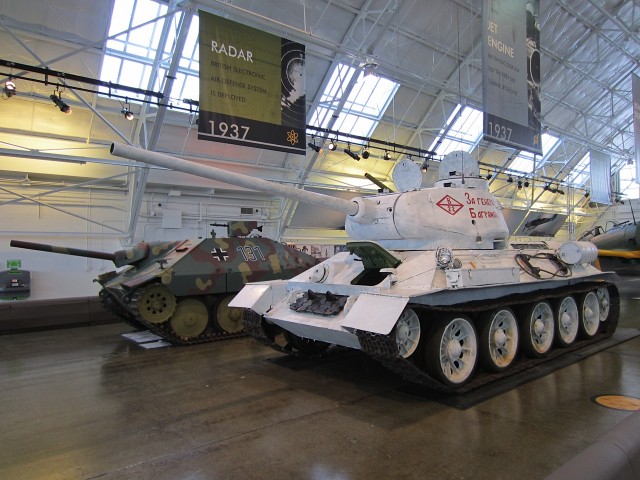
The WWII tanks at the museum--yes they can still fire and they have armor that's a good 3 inches thick
Free Fly Days
Our tour was lead by a docent, Jack. Jack was extremely well-prepared and superbly informed about each exhibit in the museum. One of the first things Jack told us was that all of the planes were in flying condition and the all tanks could still be driven and fire ammunition, making this more of a functional collection than simply a museum. As we walked around in the museum, mechanics were working on several of the planes, ensuring that they would be in good operating condition for the yearly Free Fly Days that happen every summer. The “Free Fly Days” don’t afford the public rides in the plane, but allow you to come and be part of history by witnessing the operation and flight of these historic planes as experienced pilots take off and land the planes just outside the hangar.
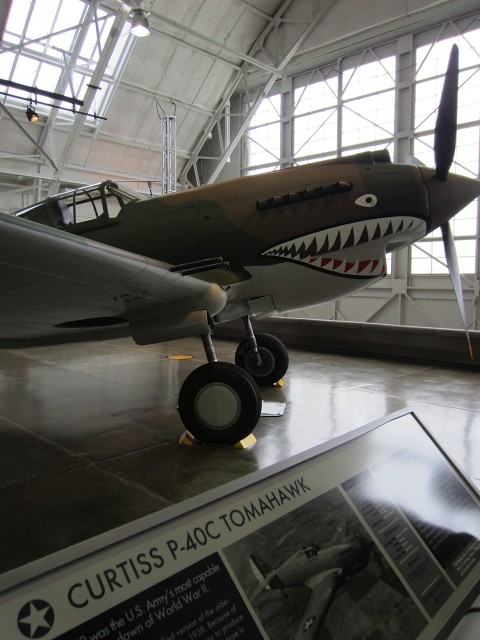
Curtiss P-40C Tomahawk: it really was painted with a shark face back during WWII
Plane Stories
Thanks to our docent we learned a great deal about the story behind each plane. Jack offered not only information about the make and model of the plane, but the history of the individual aircraft that stood before us. Every plane narrative was completely unique. From how the plane was used in the war, to what each country wanted to accomplish with their aircraft, to when and how the plane was found and eventually bought by Paul Allen to be restored. The following is one that captivated us and we wanted to share with you.
The Night Witches
The “Night Witches” were female Russian pilots who flew PO-2 biplanes during WWII. These bomber pilots were part of a unit that was entirely operated by women. As you know, for women to fly in direct combat was extremely rare at this time in history. The Soviet Union was the first country to allow women in combat after Stalin approved a plan to use this regiment of young women against the invading Germans. Many of these female pilots were teenagers at the time. The “Night Witches” would fly low over the German soldiers, with the darkness of night on their side, and conduct daring raids on the Germans. They would fly the PO-2 close to the ground, cut off its engine, so as not to attract attention, and release their bomb load as they glided.
While the Night Witches didn’t end up causing too much damage, their incessant bombing missions kept the Germans up all night, and reportedly stressed and demoralized the German troops. The German troops were also put out by the fact that these were women conducting the raids, and thus they gave them the name, “The Night Witches.” These Russian pilots earned high honors in Russia as being “Heros of the Soviet Union” during the war.
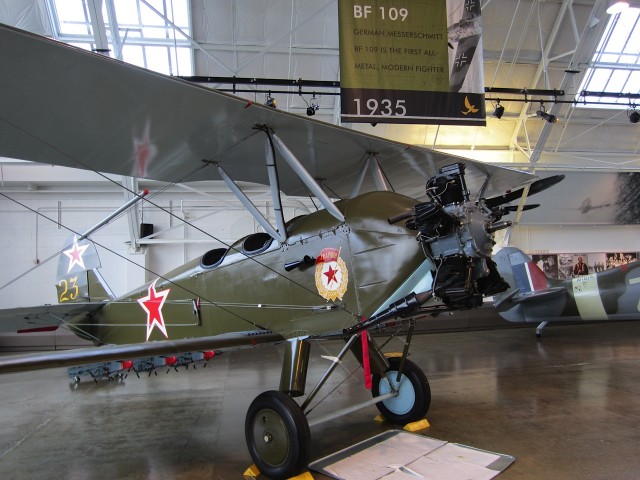
The PO-2 flown by "The Night Witches" during WWII in Soviet Russia
Sworn To Secrecy
Jack told us that even though the Night Witches were seen as heros, they had been sworn to secrecy after the war and were forced to resume their lives as housewives when the war concluded, never to unveil the fact that they were pilots, let alone that they had flown in the war. It wasn’t until the late 1980’s or 1990’s that these female Russian soldiers were able to tell their story. You’ll learn even more about the “Night Witches” at the museum when you visit.
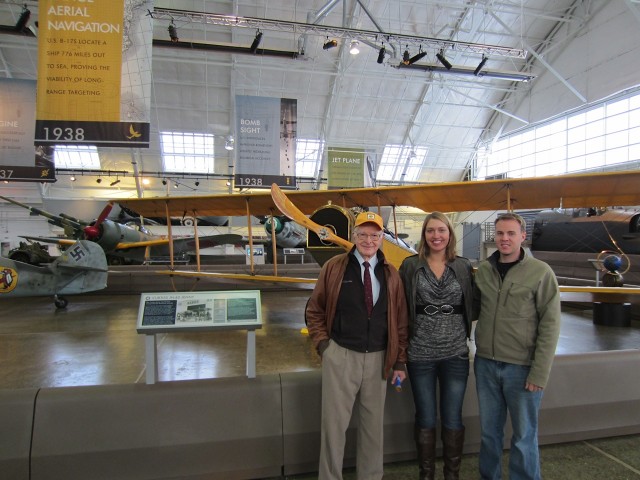
Curtis JN-4D Jenny air-craft manufactured in 1918--Amelia Earhart flew a plane like this one
Back To The Collection
We highly recommend asking for a tour guide when you arrive. Your docent will make the history of the airplanes come to life in a way that they may not otherwise. My grandfather, who has studied and known WWII aircraft for many years, said that he learned a great deal from our docent. We are looking forward to returning to the Flying Heritage Collection for their Free Fly Days to hear the planes’ motors roar and watch history soar.
Aircraft in the Collection
Artifacts
Newly added pieces include a collection of popular WWII sidearms carried by many pilots in their aircraft to offer some defense in the case of a crash-landing behind enemy lines. These include the venerable Colt M1911A1, the German 9mm Luger P08 pistol carried by many of the German officers and the 9mm Walther P38 pistol. Some of these models are still actively used today in militaries around the world.
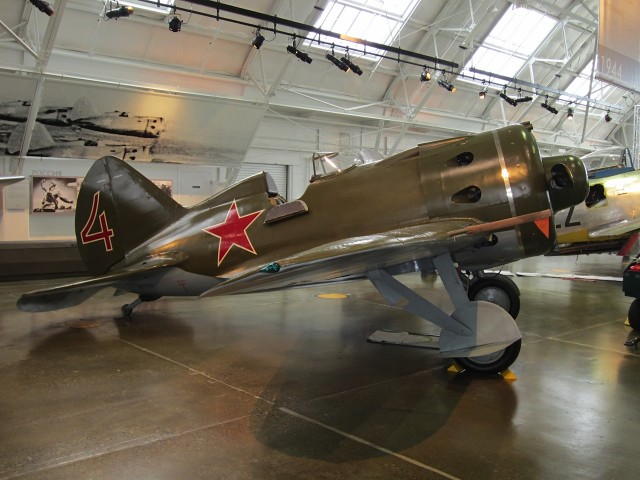
Polikarpov I-16 Type 24 "Rata"--this was a very sturdy plane that could handle being shot at much longer than many other planes
Things To Know
- Hours: Open daily 10:00 am to 5:00 pm
- This is a great outing to take your kids on, especially if they’re studying WWII history in school
- Free parking on-site
- Admission fees: Adults $12, Seniors/Military $10, Youth (6-15 years) $8, Children (5 and under) Free
- Free Fly Days: There’s usually one in June and in July, and a couple in August and in Septemberthey take out different planes on different days
Directions
From I-5 take the exit to Highway 525 toward the Mukilteo Ferry
Highway 525 will become the Mukilteo Speedway
Turn right onto Beverly Park Road
Follow the “Flying Heritage Collection” Signs to the parking lot
End at: Paine Field 3407 109th Street SW Everett, WA 98204
You can follow Maresa on her adventures at AroundPugetSound.net, via Facebook or Twitter.
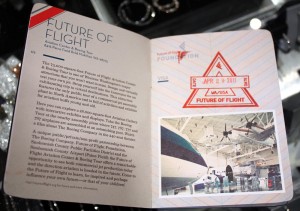
Boo ya! Got my first Paine Field Passport stamp at the Future of Flight. Now on to the others.
Visiting all the aviation attractions at Paine Field (KPAE) just got a bit cooler. Not only can you visit the Future of Flight, Museum of Flight Restoration Center, Flying Heritage Collection and the Historic Flight Foundation at Paine, but now, all of them have come together to offer the Paine Field Passport.
The Paine Field Passport only costs $10 and lasts a year. Financially it will save you 20% on admissions to any of the destinations from September to May and 20% off any of the attraction’s cafes or gift shops year round. Saving a bit of money is quite nice, but I think the actual passport itself is well worth the $10 all on its own.
Last Friday, I was able to take a visit to the Future of Flight and preview the Paine Field Passports first hand. You can either choose brown, blue or red and they have interesting history and photos of the airport (I chose the classic brown). You are also able to collect four different passport stamps from each of the vendors participating. I am proud to say I now have my Future of Flight stamp and now need to work on the rest (photo of me and my passport taken by Sandy Ward at the Future of Flight).
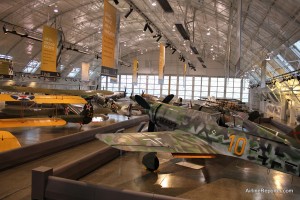
One large hangar holds all the airplanes in the Flying Heritage Collection
Around the world there are a lot of old war birds on display for many to enjoy. However, there aren’t too many that are kept in original condition and are still flyable. This is one of the things that makes the Flying Heritage Collection (FHC) stand out from others. Recently I was able to take a visit to the facility to check it out — sadly I had never been.
One of the first things I noticed when going inside the old hangar, housing the aircraft, was the smell. This is something that will not come through in the photos, but it is an important part of the experience. You can smell the fluids of the aircraft. When visiting most museums there is no smell since the aircraft have not flown in years. It feels like you are walking into a full operational hangar — and in a way you are.
Of course the smell is not the only special part of the facility, you have got to love those planes. At first site, it might seem the Flying Heritage Collection is about showing off a very slick collection of aircraft, but it is not only about the story of the planes, but also the story of technology. Finding any of these aircraft is a hard thing to do, but to find them in flying form is extremely rare. The FHC works hard to refurbish the aircraft with as many original parts as possible. Somethings like wiring needs to be updated according the FAA, but they will re-wire the plane and wrap them all in the original fabric to keep to as close to rolling out of the factory as possible.
There are two aircraft in the collection that are flyable, but are not flown. The Focke Wulf D-13 Dora and the Nakajima Ki-43-1B Hayabusa Oscar are the only examples of their kind left. The FHC doesn’t want to fly them for fear that they might be damaged or even worse crash and then there would be none left for the world to enjoy.
It is a bit surprising, when first walking into the hangar, you do not see planes, but tanks. These are a new additions to the collection and just like the airplanes, they both work. These are a new addition to the facility and were added last Memorial Day. The Soviet T-34 and a German Jagdpanzer 38(t) obviously aren’t planes, but they help to tell the story of updates in technology produced through war. Just like the airplanes, these tanks are fully functional and are able of shooting.
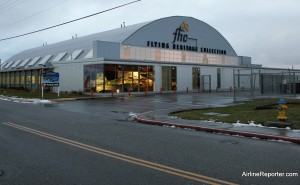
The Flying Heritage Collection is located at Paine Field in Everett, WA
Taking a look at the airplanes is quite exciting, but the FHC does a good job putting the aircraft into perspective. As you would expect in a facility like this, every airplane has a place card explaining the basics of the aircraft, but they also give a history of that individual airplane, which was quite interesting. On the walls around the facility are story boards about how each country interacted with the aircraft and gives a bit more historical significance. Hanging from the ceiling are banners that explain when new technologies were discovered. For example, there was a banner that explained in 1942 ejection seats were invented and increased the odds of a pilot’s survival. It is interesting to compare the dates from the banners with the dates the aircraft were produced.
When I asked about how much each aircraft cost, I was told “a lot.” I would imagine that “a lot,” might be an understatement, it can’t be cheap to keep the planes in the condition that they are. Cost of the aircraft really isn’t a huge issue, since the facility is owned by Paul Allen, co-founder of Microsoft and chairman of Vulcan. On top of giving a lot of his money away for good causes, he also has a lot of fun toys. Luckily for us, he has decided to share his collection of warbirds with the public through his non-profit organization, Friends of Flying Heritage that supports the collection.
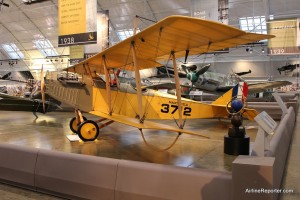
The oldest aircraft they have is the Curtis JN-4D Jenny - and it still flies.
The collection was open to the public in 2004 and was housed in Arlington, WA (about an hour north of Seattle, WA). In 2008 they moved to their current facility right on Paine Field. Right now there is only one more slot left for another plane and I was told they might have to start storing aircraft in Arlington and rotate them through the collection. Although it would be better to see all the collection at any given time, this also means you might be able to catch one flying between the two airports, which is always a good thing.
If you haven’t done so already, head on over to the Flying Heritage Collection and check them out. Tickets are only $12 and less for kids and seniors. Also be sure to make it to Paine Field for their Free Fly Days when you can watch them fly for free over the summer. They will fly the planes 10 different days over the summer, kicking it off during General Aviation Day.
I will be adding this write up in the Aviation in Seattle page, it should make a great addition. A special thanks to the Flying Heritage Collection and Snohomish County Tourism Bureau for setting up my visit.
MORE FUN STUFF:
* 29 Photos of my visit to the collection
* See photos of the planes flying from Liz Matzelle (be sure to catch the one with 787 ZA005 and the spitfire)
* Flying Heritage Collection Facebook page
* Build your own warbird on their website
* Photos of the tanks firing at Paine Field last year from the SEattle PI

























